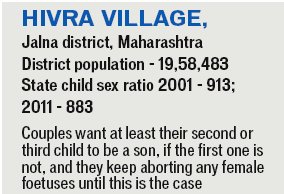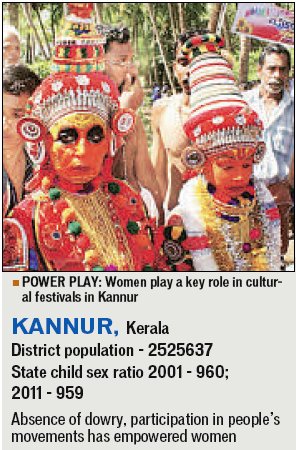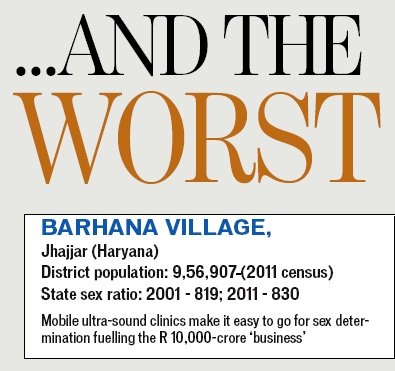
GROUND REPORT India's child sex ratio has dropped from 927 to 914 girls per 1,000 boys according to Census 2011.
To understand the problem, HT travels to districts in 4 states, each of which present a different scenario - either displaying remarkable improvement or
decline from 2001
THE BEST PLACE TO BE A
GIRL CHILD...

 ON THE RISE ON THE RISE
HIMACHAL DISTRICT EMERGES TOP SCORER
Govt cracks down on pre-natal tests
Aasheesh Sharma
º [email protected]
The village is under a thick white blanket. Hurling gets cut off from the rest of India every time it snows. And for the past three days, it has snowed heavily in the upper
reaches of Spiti, Himachal Pradesh.
So, the news that Lahaul-Spiti has
topped Indian districts with a child sex
ratio of 1013 works like an icebreaker.
"Really?" exclaims Yeshey Dolma, who
teaches in the village school. "I didn't
know this. And how would we know?
No newspapers reach Spiti between
October and May."
NS Bist, Professor, Himachal Pradesh
University, who specialises in demography
and population studies, says
women, who work in the fields, are the
family's mainstay.
"Cultivation in the
tribal districts of Lahaul, Spiti and
Kinnaur is carried out by women
between April and November. Also, for
the last four years, the government has
implemented the Pre-Natal Diagnostic
Techniques Act more forcefully. This
has reflected in Census 2011."
Butite Jagmo, 11, one of Dolma's students,
hasn't just out-studied her fifthclass
dropout dad Chunni Lal, but her
unlettered mother and grandma as well.
Butite's mother wasn't allowed to attend
school. "I was made to cultivate rice
instead. I have ensured it doesn't happen
to my daughter," she says.
At the senior secondary school in
district headquarters Kaza, 25 km from
Butite's home, in subzero conditions, a
group of girls is sweating it out on the
basketball court. "They are my powerpuff
girls: they always beat the boys at
studies and sports," says their history
teacher Dikit Dolker.
At home, the boys have it easier.
School or no school, girls begin their
day cooking rice for the family, says
Nawang Dumgzo, a Class X student. "I
then wash the floors and fetch water
as the pipes get frozen. After school
between 10 am and 4 pm, I return and
again cook dinner," adds Dumgzo. "All
that boys do is while away time playing
or watching cricket," she says.
Since the last Census in 2001, people
in Lahaul-Spiti have realised that
the "sincere" girls also take better care
of their elders, says sociologist Sonam
Angdui, from Spiti's erstwhile royal
family.
"Boys take to drinking in their
teens, drop out and become taxi drivers
or construction contractors. By the
time they are 40, they turn into alcoholics."
Religion also affects the region's
demography, says Kishore Thukral,
author of Spiti, Through Legend and Lore.
Between 700-800 monks inhabit Spiti's
Kee, Tangyud, Dhankar, Tabo and
Kumgry monasteries.
Most villagers
send one of their children to embrace
monkhood. "Which could be why
Lahaul-Spiti's population hasn't grown
as rapidly as other districts," says
Angdui.
In the 2011 Census, the population of
Lahaul and Spiti actually dropped from
33,224 in 2001 to 31,528 in 2001.
Celebrated agricultural scientist MS
Swaminathan says Spiti's arid
weatherand the capacity to keep seeds
dry is ideal for multiple crops. "If we
develop its marketing potential the
district can turn into another
Switzerland," he says.
Much before Swaminathan, a
certain Rudyard Kipling praised Spiti
with these words in the classic Kim:
"Surely the Gods live here…This is no
place for men."
He could well have been talking about
the age of the girl child. |

Everyone wants a boy
Prachi Prnglay
º [email protected]
 In her thirties, Sunita admits that
she has undergone two sex determination
tests and then two abortions
when she found out she was
pregnant with girls. The boy came
after the two abortions. "We needed a
son who can look after us when are old,"
the housewife married to a farm labourer
in Hivra village in Jalna district of
western Maharashtra, 335 km northeast
from Mumbai. In her thirties, Sunita admits that
she has undergone two sex determination
tests and then two abortions
when she found out she was
pregnant with girls. The boy came
after the two abortions. "We needed a
son who can look after us when are old,"
the housewife married to a farm labourer
in Hivra village in Jalna district of
western Maharashtra, 335 km northeast
from Mumbai.
Records at the nearest primary
health centre show that in the past year
only 239 girls were born in 17 surrounding
villages, compared with 349
males. The child sex ratio in the whole
district has dropped to 847 girls per
1,000 boys, the 2011 census has revealed,
from 904 girls in 2001.
Activists say that the practice of
women undergoing sex determination
tests is widespread in this and other
villages of Jalna, a largely agricultural
district. The long-standing factors driving
this trend arise from the social system
entrenched in this village, as in millions
of others in the country: one in
which only men inherit property, carry
forward the family name, execute all
rituals, receive dowry from their wives
and are supposed to look after their
parents. More recent factors are the
easy availability of sonography
machines and an increasing awareness
about family planning.
"In the past, women could keep trying
for a son," says Kirti Udhan, chairman,
Jalna Zilla Parishad. "So you would
see women bearing seven to eight daughters
before finally giving birth to a son.
Now because of economic compulsions,
couples want at least their second or
third child to be a son, if the first one is
not, and they keep aborting any female
foetuses until this is the case."
STILL GOOD IN KERALA, NUMBER
OF GIRLS HIGHER
THAN THE NATIONAL
AVERAGE
Sucheth PR
º [email protected]
 Any imbalance in sex ratio is a
disturbing fact. But when the
number of girls exceeds that of
boys, it says positive things
about the social fabric. The politically
vibrant Kannur district of Kerala has
topped the sex ratio in the country as
per the 2011 census. Kannur has a sex
ratio of 1,133 females for 1,000 males,
much higher than the national average.
What contributed to its gender balance?
Kannur's long history of people's
struggles for social justice, the freedom
struggle and the Communist movement
that encouraged female initiatives in
social issues - all played their part.
"Rearing up girl children and giving
them in marriage is less expensive in
this region compared to other parts of
the state," says Professor Lakshmanan,
former director of KILA (Kerala
Institute of Local Administration).
The legacy of the female rulers of
Arakkal, the sole Muslim dynasty of
Kerala is still inspiringly alive in the
social memory of the district. Bibi
Harrabichi Kadavube ruled Kannur
during the first half of the eighteenth
century. The last ruler of the kingdom
was also a woman - Ali Raja
Mariumma Beevi Thangal.
The girl child was also supported by
its culture industry. Indulekha, the first
novel in Malayalam authored by
O.Chandu Menon was published from
Thalassery, a major town in Kannur
district known as the cultural capital
of north Kerala. The novel presents a
bold female character who challenges
the patriarchal Brahmanical hegemony
while the hero of the novel,
Madhavan, is feeble in attitude. The
total absence of the burden of the dowry
system among the Hindu community,
here, is a pivotal factor in the welcome
the girl child gets at birth.
The writer is a research scholar |
  HELL- HOLE JHAJJAR RANKS BOTTOM IN CHILD SEX RATIO
Too macho to have a girl child
Praveen Donthi
º [email protected]
Pardeep (25), the popular sarpanch of Barhana, is a reluctant bachelor. The resident of a state that has the country's worst stats in sex ratio with 830 women per 1,000 men - Jhajjar is its worst district at 774 - he is finding it difficult to find a girl to marry. Barhana is Jhajjar's worst case - in 2010, there were 203 births - 148 boys and 55 girls so the sex ratio of this village with a population of 8,890 is 378.
The reason for not being able to find a bride is because there is less land left in the village, says Pardeep. Bhaarat Singh (53), Chief Medical Officer, Jhajjar, has his reasons for the sex ratio skew:
a) The 2003 amendment of PNDT Act, 1994, that allowed mobile ultra-sound clinics making it easier for sex determination b) PNDT Act not being under CrPC makes it easy for guilty doctors to get away c) Governmental promotion of 'small family' that encourages people to go for sterilisation if the first-born is a son.
BS Dahiya, former director general of health services of the state, who takes the credit for booking the first case under PNDT Act, says, "it's all happening because it is a R 10,000- crore business."
CMO, Jhajjar, also cites regional machismo as the reason for the decrease in girl children. "Because it is dominated by the martial races, there is the tendency to have more sons."
The imbalance in sex ratio has triggered many social and cultural problems. Brides are being brought from other states but many run away. The crime rate has gone up too. "There have been 2 to 3 rape cases per month," says Singh. The increasing crime in turn is "discouraging" them from having a girl child many claimed during the interview.
|


 Any imbalance in sex ratio is a
disturbing fact. But when the
number of girls exceeds that of
boys, it says positive things
about the social fabric. The politically
vibrant Kannur district of Kerala has
topped the sex ratio in the country as
per the 2011 census. Kannur has a sex
ratio of 1,133 females for 1,000 males,
much higher than the national average.
Any imbalance in sex ratio is a
disturbing fact. But when the
number of girls exceeds that of
boys, it says positive things
about the social fabric. The politically
vibrant Kannur district of Kerala has
topped the sex ratio in the country as
per the 2011 census. Kannur has a sex
ratio of 1,133 females for 1,000 males,
much higher than the national average.




 ON THE RISE
ON THE RISE In her thirties, Sunita admits that
she has undergone two sex determination
tests and then two abortions
when she found out she was
pregnant with girls. The boy came
after the two abortions. "We needed a
son who can look after us when are old,"
the housewife married to a farm labourer
in Hivra village in Jalna district of
western Maharashtra, 335 km northeast
from Mumbai.
In her thirties, Sunita admits that
she has undergone two sex determination
tests and then two abortions
when she found out she was
pregnant with girls. The boy came
after the two abortions. "We needed a
son who can look after us when are old,"
the housewife married to a farm labourer
in Hivra village in Jalna district of
western Maharashtra, 335 km northeast
from Mumbai.